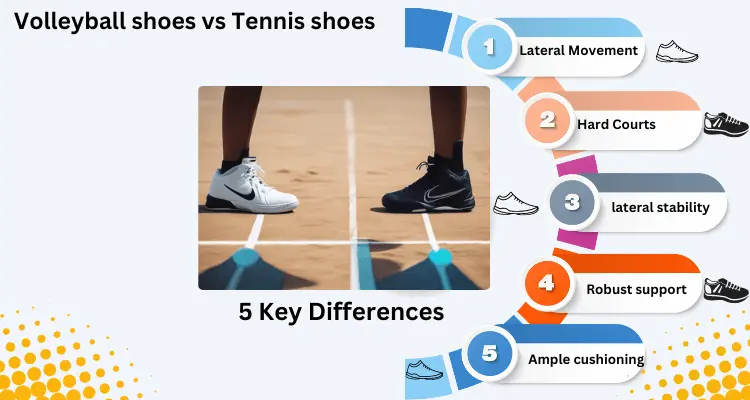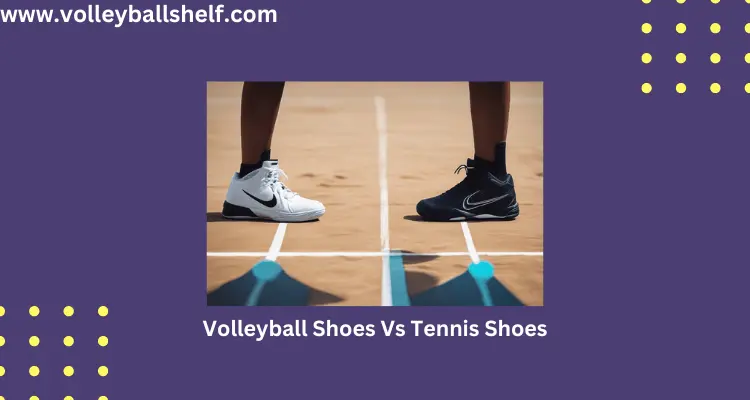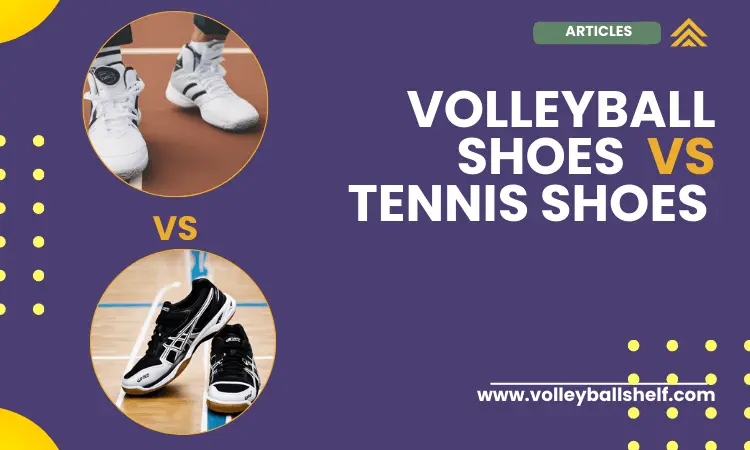Introduction
A sports enthusiast knows the importance of the right gear in enhancing performance. The athletic shoe market is flooded with a wide range of shoes designed for specific sports – from basketball to tennis to volleyball, each pair meticulously crafted to support the distinctive movements of each game.
This article will delve deep into the volleyball shoes vs tennis shoes and will discuss about distinguishing features, pros, and cons of volleyball and tennis shoes, providing an in-depth comparison that will help you make an informed decision the next time you hit the sports store.
Quick Response
In volleyball shoes vs tennis shoes both are specialized footwear designed for the respective sports. Volleyball shoes prioritize lightweight construction, cushioning, and grip to support quick lateral movements and jumps on indoor courts. In contrast, tennis shoes are built for durability, lateral stability, and traction on various court surfaces, catering to the back-and-forth motions and rapid direction changes of tennis gameplay.
Main Differences: Volleyball Shoes vs Tennis Shoes
Choosing between volleyball and tennis shoes isn’t a matter of which looks better; it’s about understanding the unique demands of each sport. Below, we dissect the components of volleyball and tennis shoes, emphasizing their similarities and differences.

Volleyball Shoes: Engineered for Lateral Movement
Volleyball is a game of swift lateral movements, vertical leaps, and fast-paced action. Volleyball shoes are explicitly designed to cater to these needs, focusing on providing stability, traction, flexibility, and ample cushioning.
Industry-leading brands, such as Asics and Mizuno, have developed volleyball shoes that encompass these features.
The gum rubber soles in volleyball shoes offer excellent grip, crucial for the rapid movements on gym floors.
Lightweight mesh uppers ensure breathability, keeping your feet comfortable during long matches. The shoes also come with additional arch support to provide stability during jumps and lunges.
The midsole offers extra cushioning for impact protection, enhancing the player’s performance by reducing the risk of injury. Lastly, the toe area is often reinforced for durability, acknowledging the common practice of toe dragging during intense volleyball matches.
Tennis Shoes: Designed for the Demands of Hard Courts
Tennis is a sport that involves a mix of lateral and linear movements, requiring shoes that offer robust support, stability, flexibility, and superior durability.
Prominent brands like Nike and Adidas have championed the design of tennis shoes, offering products that excel on hard courts.
Tennis shoes typically come with non-marking rubber soles, preventing any damage to the court surfaces. These soles are often designed with a herringbone pattern that provides excellent grip and aids in swift movements.
The midsoles of tennis shoes are cushioned to absorb impact and offer comfort during long matches. Compared to volleyball shoes, tennis shoes often have a more robust build to withstand the high-wear conditions of hard tennis courts.
Tennis Shoes on the Volleyball Court: A Plausible Alternative?
Though it might seem tempting to use tennis shoes for a volleyball game, they may not be the most suitable choice. Volleyball shoes are specially designed to handle the sport’s dynamic lateral movement, offering superior traction and grip on gym floors.
On the other hand, tennis shoes are tailored to the needs of hard courts and might not provide the same level of performance on indoor volleyball courts.
Volleyball Footwear: The Right Shoes for the Right Game
For volleyball, professional players generally lean towards shoes specifically designed for the sport. These shoes are crafted considering the unique movements and requirements of volleyball, providing necessary stability, support, and cushioning.
A good volleyball shoe is not just about function; it’s lightweight and flexible, featuring a gum rubber sole for unparalleled traction on gym floors.
Volleyball Shoes: How They Differentiate from Other Sports Shoes
Volleyball shoes distinguish themselves from other sports shoes, including running shoes and basketball shoes, through unique features tailored to the sport’s needs.
These shoes provide superior lateral stability, usually achieved by having a broader, flatter sole.
The midsole is more cushioned than that of other sports shoes, helping players cope with the constant jumping involved in the sport. They are also typically lighter, facilitating agility and speed on the court.
Volleyball Shoes: Unpacking the Strengths and Potential Pitfalls
Like any product, volleyball shoes come with their own set of advantages and disadvantages. Their excellent grip on indoor courts, top-notch cushioning, and robust lateral support make them a favorite among volleyball players.
However, they might not offer the same level of durability as some other sports shoes. Since they are optimized for volleyball-specific movements and surfaces, their use may be restricted outside the volleyball court.
Any Shoe for Volleyball: Exploring the Myth
While it is technically possible to wear any shoe for a volleyball game, it’s not the most advisable strategy. Each sport has specific demands, and the shoes are designed accordingly.
For instance, running shoes are designed for forward motion and might not offer the same lateral support as volleyball shoes. Similarly, basketball shoes are usually heavier and might restrict your agility on the volleyball court.
Choosing the Ideal Volleyball Shoes: Factors to Consider
When choosing volleyball shoes, consider factors such as your playing position, comfort level, durability, traction, and the shoe’s weight. Good volleyball shoes offer sturdy arch support, have a lightweight construction, and feature a non-marking gum rubber sole for excellent traction on indoor courts.
Volleyball Shoes on the Tennis Court: An Inefficient Match?
While there’s no hard and fast rule against using volleyball shoes for tennis, they might not perform as well as tennis-specific shoes. The main difference lies in the soles – volleyball shoes have a gum rubber sole designed for indoor gym floors, not the abrasive surface of a tennis court. They also lack the durability necessary to endure the demands of tennis.

Tennis Court Shoes: The Versatile All-Rounder
If versatility is your priority, tennis court shoes might be a suitable option. Designed to perform on various court surfaces, they offer a decent balance of traction, stability, support, and durability. However, they might not excel in the specific features that sport-specific shoes, such as volleyball or tennis shoes, provide.
In conclusion, the right footwear is a crucial part of your athletic gear. There are several nuances between volleyball shoes and tennis shoes that could significantly impact your performance on the court. Whether you’re a passionate volleyball player or a tennis enthusiast, choosing sport-specific shoes will undoubtedly give you a competitive edge.
Always remember, your shoes are an extension of your game – choose wisely and play passionately.
Conclusion
Breaking down the differences between volleyball and tennis shoes is more than a mere exercise in footwear comparison. It’s an integral part of understanding the mechanics of each sport, the unique demands they impose on the athlete, and how the right gear can significantly impact one’s performance.
Volleyball shoes, tailored to cater to the rapid lateral movements and vertical leaps, offer excellent traction, cushioning, and flexibility. They are designed to maximize performance on indoor gym floors.
Tennis shoes, on the other hand, have a more robust build, designed to endure the high-wear conditions of hard courts, providing substantial support, durability, and grip.
Though tennis shoes can be an alternative on the volleyball court, they might not perform as efficiently as volleyball-specific shoes. Similarly, using volleyball shoes for tennis might not yield the best results due to differences in sole construction and durability.
When choosing shoes, sport-specific requirements must be the priority. Both volleyball and tennis shoes have been designed keeping in mind the distinctive demands of their respective sports.
While tennis court shoes might offer versatility across various sports, they may not excel in specific, sport-oriented features that shoes like volleyball or tennis shoes provide.
Ultimately, your shoes are an extension of your game. Whether you’re an avid volleyball player or a seasoned tennis enthusiast, selecting the appropriate footwear will certainly give you a competitive edge.
Remember, an informed choice today can significantly elevate your performance tomorrow, so choose wisely and let your feet lead you to victory.



![When to get new volleyball shoes? [3 key signs]](https://volleyballshelf.com/wp-content/uploads/2023/09/When-to-get-new-volleyball-shoes.webp)
![Volleyball Shoes Asics Vs Mizuno – A Comprehensive Review [4 key Differences]](https://volleyballshelf.com/wp-content/uploads/2023/08/Volleyball-Shoes-Asics-Vs-Mizuno.webp)
![Can You Wear Volleyball shoes Outside? [4 Reasons]](https://volleyballshelf.com/wp-content/uploads/2023/08/www.reallygreatsite.com-2-1.webp)
![Mastering the Art of How to clean Volleyball Shoes in 2023? [2 Effective ways]](https://volleyballshelf.com/wp-content/uploads/2023/08/www.reallygreatsite.com-1.webp)
![Are volleyball shoes good for pickleball? [4 key Differences]](https://volleyballshelf.com/wp-content/uploads/2023/09/are-volleyball-shoes-good-for-pickleball.webp)
![Can Volleyball Shoes Be Used for Netball? [3 key reasons]](https://volleyballshelf.com/wp-content/uploads/2023/09/Can-Volleyball-Shoes-Be-Used-for-Netball.webp)